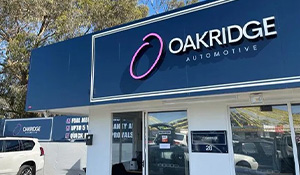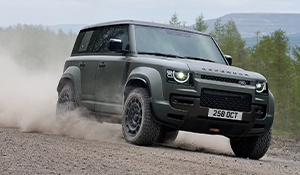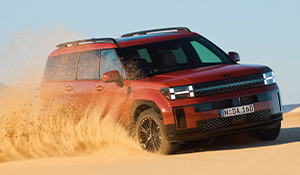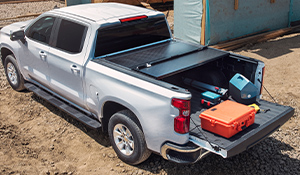Top 5: Bush Wagons
Whether new or secondhand, these are the top five bush wagons that can take you to the most hard-to-reach places in Australia… and get you home again.
Aussie consumers have never had it so good with so many 4x4 wagons on the market, from the humble $23k Suzuki Jimny to the outrageously expensive $430k Bentley Bentayga. But while there are many wagons that wear a 4x4 badge on their tailgate, most of them will never see a gravel road, let alone climb an alpine track or traverse a desert.

To make it as a successful bush rig, a wagon must have more than just off-road capability; it must also offer a decent touring range, impressive load carrying capacity and good reliability. A dose of toughness, practicality and functionality also doesn’t go astray, and it will need to be supported by the 4x4 aftermarket, so it can be equipped with protection equipment and other gear.
As modern vehicles become more complex, many have lost the attributes that make for a decent bush wagon. While there are still a couple of new 4x4 wagons that make the grade, to complete our list of five we’ve also had to look to the secondhand market.
Toyota LandCruiser 70 Series. The LandCruiser 70 Series is only one of two new vehicles to make the list, and it’s our number-one pick as a bush wagon thanks to its inherent simplicity, off-road capability and unequalled parts and service back up.
The LC70 was launched way back in 1984 but it has been significantly upgraded over the years. There are currently two options for those after a wagon: the 76 Wagon and the 78 TroopCarrier. Both models feature a tough separate chassis and live-axles front and rear, with coils up front and leaf springs at the rear.

While the Troopie has been around for decades, the 76 Wagon wasn’t launched in Australia until 2007. Both are these days powered by a 4.5-litre V8 turbo-diesel engine that makes a claimed 151kW and 430Nm from a low 1200rpm. The only transmission option is a five-speed manual gearbox and the LC70 runs a part-time 4x4 system with two-speed transfer case.
All 70 Series Cruisers have a straightforward driveline, with a five-speed manual gearbox and part-time 4X4 system. The LC70 offers impressive off-road performance thanks to good ground clearance, plenty of axle articulation, good chassis flex and impressive low-range reduction. The upper-spec GXL variants are equipped with front and rear diff locks, providing even greater off-road capability.

When it comes to touring comfort, the LC70 is pretty basic. Workmate variants have vinyl floors and seats, while GXLs score cloth seats and carpet. Even air conditioning is optional. A revision to transmission ratios in 2016 resulted in more relaxed highway touring, thanks to a taller fifth gear, and LC70s are now equipped with ABS, vehicle stability control (VSC), active traction control (A-TRC), hill-start assist control (HAC), brake assist and electronic brake-force distribution.
The 76 Wagon has a decent-size 130L fuel tank, while the Troopie Workmate makes do with a 90L tank. The Troopie GXL, however, scores two 90L fuel tanks for one of the best touring ranges on the market. The Troopie offers way more cargo space than the Wagon, but only two doors, so can be a less practical option for those travelling with kids.
Prices for the 76/78 range from $63,740 to $70,740, but if your budget doesn’t stretch to that there are plenty of secondhand examples on the market, but many with very high mileage that have had a very tough life, so choose wisely. And if a TDV8 model is out of reach, there are several earlier TroopCarrier models worth considering, including those powered by the 1HD-FTE 4.2-litre direct-injection six-cylinder turbo-diesel engine, which made 122kW/380Nm, or the virtually indestructible (but slow) 1HZ 4.2-litre indirect-injection naturally aspirated diesel, which developed a paltry but ever-reliable 96kW/285Nm.

Mercedes-Benz G 300 CDI Professional. The Mercedes-Benz G 300 CDI Professional was designed for military use but it translates well for those who want to employ it in a bush-touring role.
The Wagon can haul a 1200kg+ payload and like the LC70, the G 300 Pro has a separate chassis and live axles front and rear, but with coil springs at both ends. It has a full-time 4x4 system with front, centre and rear locking diffs, and its 3.0L TDV6 engine is mated to a five-speed automatic transmission.

To enhance its bush capability, the engine has been tuned to run on the dodgiest quality fuels, and as such only has modest outputs of 135kW at 3800rpm and 400Nm between 1600-2600rpm. While this doesn’t make for particularly good on-road performance, the G 300 Pro is an absolute weapon off the road.
The interior of the G 300 Pro even makes the LC70 look luxurious; it has vinyl floor covering, cloth seats, manually winding windows and no cup holders. It does, however, have standard air conditioning, and for those with the money to spare it can be optioned with leather-covered heated seats, power mirrors and a timber floor in the cargo area.

The G 300 Pro’s ride quality on bumpy tracks isn’t great but improves with a decent load on board. Brick-outhouse aerodynamics make driving on the highway a chore; it is blown around by crosswinds and you have to shout if you want to converse with passengers. It’s also thirsty on the highway but comes with a 97-litre fuel tank.
Once you’re off the road the G 300 Pro shines; it has loads of ground clearance, fantastic low-range reduction and standard fitment 265/70R16 all-terrain tyres. The G 300 Pro comes with a snorkel and rated recovery points, and options include a factory bull bar, side rails, tow bar and walk-on bonnet.

In a concession to modernity, the G 300 Pro is equipped with ABS with BA and EBD, as well as ESP. Those who can afford to fork out the $109,900 asking price for a G 300 Pro won’t have to worry about GVM upgrades and the like; this rig is more than capable of carrying big loads in the bush without modification.

Nissan GU Patrol. Nissan retired the GU Patrol in 2016 much to the disappointment of those who had come to love its combination of simplicity, strength and off-road capability, which made it an ideal candidate as a bush rig.
The GU Patrol was launched in 1997 with essentially the same separate chassis and suspension as its GQ predecessor, with live axles front and rear, and coil springs.

The most-recent models were powered by the ZD30 3.0-litre four-cylinder common-rail turbo-diesel engine that made a claimed 118kW and 380Nm of torque from 2000-2400rpm. This engine has a chequered history, but for those after a reliable bush-rig the earlier model TD42T mechanically injected six-cylinder turbo-diesel engine is a much better bet. From 2003 the TD42T was equipped with an intercooler and it developed a claimed 114kW/360Nm; hardly impressive output by today’s standards but with this engine reliability and simplicity are the name of the game.
If you can make do with 91kW and 272Nm, the naturally aspirated version of the TD42 diesel is also a good option, and there are several aftermarket turbo and intercooler kits to suit it. Both the TD42 and TD42T were retired in 2006, so finding low-mileage examples is no easy task, but if they’ve been properly maintained this shouldn’t present a problem.

The Patrol has a part-time 4x4 system with two-speed transfer case and manually locking hubs on DX models and auto-locking hubs on ST models. It offers plenty of ground clearance, excellent axle articulation, and is well suited to the demands of off-road driving. Having been on the market for an impressive 19 years, there are lots of aftermarket accessories to suit the GU Patrol.
The interior of the Patrol offers good space and comfort. Equipment levels are dependent on model grade. The DX was all vinyl and cloth, while the ST offered velour, carpet and power windows.

While it can’t quite match Toyota for servicing and parts back up, Nissan still has a good presence in rural and remote areas. And as many parts are the same as those used in the older GQ Patrol, which has been around since 1987, you should have no problems sourcing bits and pieces if you get into strife in remote areas.
Late model 2006 Patrol TD42Ts range in price from $16,000-$18,000 for a DX and $17,000-$20,000 for an ST, and mileage will be anywhere between 180,000-280,000km. The last-of-the-line 2016 Patrol Legend Editions, with the ZD30 turbo-diesel mated a four-speed auto, go for between $43,000-$47,000, and will have low mileage between 15,000-40,000km.

Land Rover Defender. Tracing its lineage back to the original Land Rover of 1948, the Defender has a long history of its own with the nameplate first being used as early as 1990. Much to the disappointment of enthusiasts the world over, the Defender ceased production in 2016.
This tough as guts bush rig is the perfect example of form follows function, with a tough separate chassis and aluminium body, live axles front and rear, and long travel coil springs all-round. There have been several diesel engines used in Defender over the years, always mated to a manual transmission with a full-time 4x4 system, lockable centre diff and two-speed transfer case.

For bush tourers the Defender 110 Wagon is the pick of the range, although plenty still opt for the short-wheelbase Defender 90. The Defender was initially powered by a 2.5-litre four-cylinder turbo-diesel engine (200Tdi), which was replaced in 1995 by the updated 300Tdi. With no electronics, many enthusiasts swear by these older engines, and recommend them as the pick of the breed for serious global overlanding. A five-cylinder turbo-diesel (Td5) was launched in 1998 and it featured electronic unit injection, then in 2007 the Defender was fitted with a 2.4-litre four-cylinder Ford turbo-diesel engine mated to a six-speed manual gearbox. A 2.2-litre four-cylinder turbo-diesel was fitted from 2012.
Over the years the Defender also scored technology upgrades, including the introduction of electronic traction control in 2000, and a redesigned interior with more effective air conditioning in 2007. Nevertheless, all Defenders have a narrow cabin and cramped driving position, but for those who can live with these compromises the 110 is a great long-distance tourer; it offers a good payload capacity and a cavernous cargo area.

Anyone who’s driven a Defender in anger will agree that off-road capability is up there with the best, thanks to excellent low-range reduction combined with good low-rpm torque and good axle articulation. A 75-litre fuel tank (in the 110) doesn’t sound like much but all of the turbo-diesel engines offered over the years have proved economical.
Like the LandCruiser 70 and the GU Patrol, a long model lifespan means there are plenty of aftermarket accessories available for the Defender.

Secondhand prices have been on the up since production ended, so Defenders are a good investment. Good examples of the early 200Tdi and 300Tdi models can be had for less than $20k, while Td5s will be a little more. It’s a good idea to have a Land Rover specialist look over any intended purchase before you hand over any cash.
Models fitted with the Ford 2.4-litre turbo-diesel cost as much as $30,000-$40,000 and the latest 2.2-litre 110 wagons will set you back anywhere between $50,000-$60,000, which is more than what they cost when new! While Defenders don’t have a fantastic reputation for reliability, this is not necessarily deserved… so long as they’re regularly serviced by a specialist.

Toyota LandCruiser 105. Many enthusiasts reckon the HZJ105 LandCruiser was the last genuine bush wagon from Toyota other than agricultural 70 Series. Manufactured from 1998 to 2007, the HZJ105 was the last LandCruiser to be fitted with live-axles front and rear with coil springs all round, and it was available only in lower grade Standard or GXL spec levels.
The Standard is pretty basic with vinyl seats and floor covering, skinny steel rims and a basic barn-door arrangement at the back. But that’s the kind of trim you want in a bush wagon. The GXL was a little fancier, with eight cloth-covered seats, carpet, optional four-speed auto transmission and horizontally split two-piece tailgate.

Power comes from an asthmatic 1HZ indirect injection, naturally aspirated 4.2-litre six-cylinder diesel, which makes a modest 96kW at 3800rpm and 285Nm of torque at 2200rpm. Performance ain’t great but the 1HZ is incredibly reliable and relatively easy to fix if something does go wrong. It also takes well to fitment of an aftermarket turbo and intercooler, and plenty of examples on the used-vehicle market will have been subjected to such an upgrade.
The LandCruiser has an auxiliary fuel tank that stretches capacity out to a handy 145-litres, but expect fuel consumption in excess of 12.5L/100km, or more when fully laden and driving off-road. Payload ranges from 700-900kg depending on spec level/transmission, which is pretty handy for a bush wagon that will likely see duty on extended trips.

Sourcing parts for the HZJ105 is easy; the 1HZ diesel engine has been around for a long time and it has seen service in various other vehicles including the LC70 and Toyota buses and trucks. The 4x4 aftermarket makes just about everything you can think of to suit the HZJ105 LandCruiser, and many examples on the secondhand market will be loaded to the hilt with gear, from protection equipment to suspension kits to long-range fuel tanks and more.
You can pick up a high-mileage 1998 model HZJ105 for as little as $15k, but expect it to have had a fairly tough life for this kind of money. Late-model examples go for between $20,000-$30,000, and most in this price bracket will have around 200,000-250,000km showing on the odo.
Words Dean Mellor










